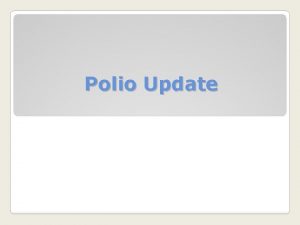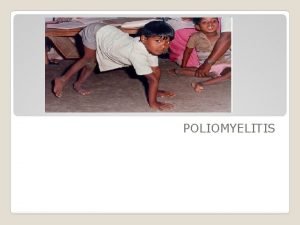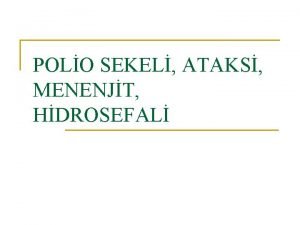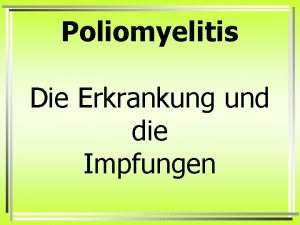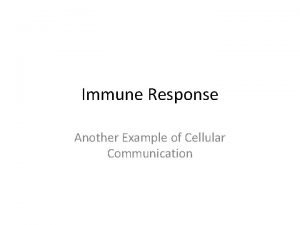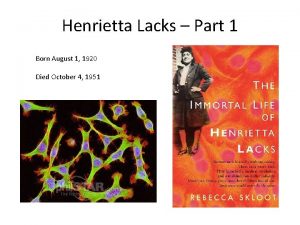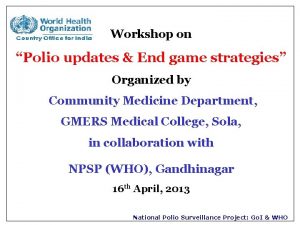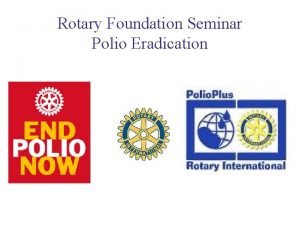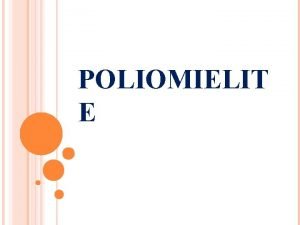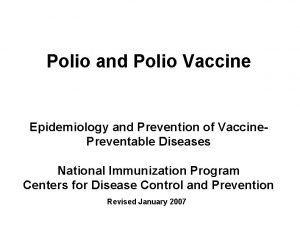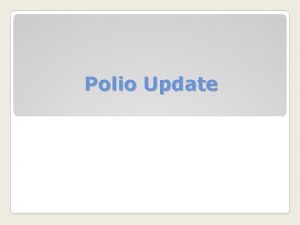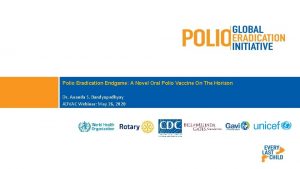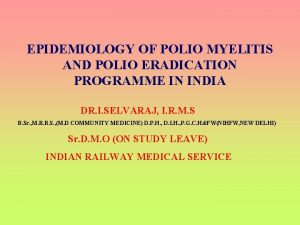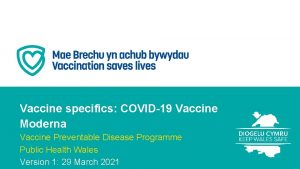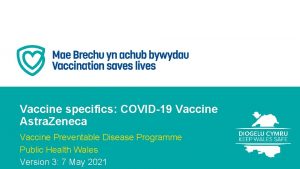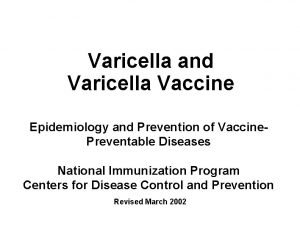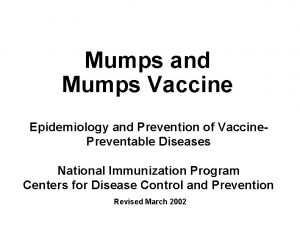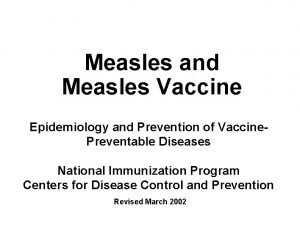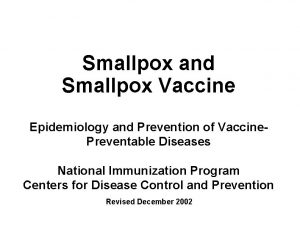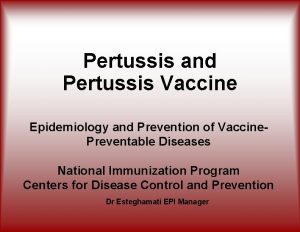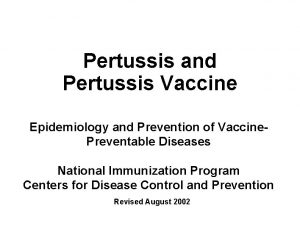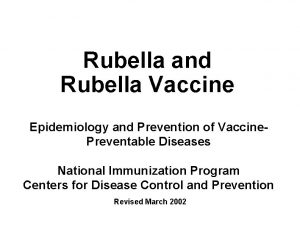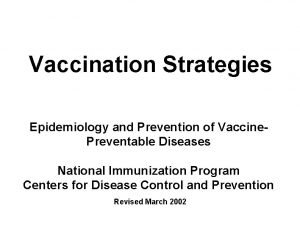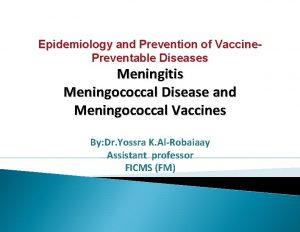Polio and Polio Vaccine Epidemiology and Prevention of





























- Slides: 29

Polio and Polio Vaccine Epidemiology and Prevention of Vaccine. Preventable Diseases National Immunization Program Centers for Disease Control and Prevention Revised March 2002

Poliomyelitis • First described by Michael Underwood in 1789 • First outbreak described in U. S. in 1843 • 21, 000 paralytic cases reported in the United States in 1952 • Global eradication in near future

Poliovirus • Enterovirus (RNA) • Three serotypes: 1, 2, 3 • Minimal heterotypic immunity between serotypes • Rapidly inactivated by heat, formaldehyde, chlorine, ultraviolet light

Poliomyelitis Pathogenesis • Entry into mouth • Replication in pharynx, GI tract, local lymphatics • Hematologic spread to lymphatics and central nervous system • Viral spread along nerve fibers • Destruction of motor neurons

Outcomes of poliovirus infection

Poliovirus Epidemiology • Reservoir Human • Transmission Fecal-oral Oral-oral possible • Communicability 7 -10 days before onset Virus present in stool 3 -6 weeks

Poliomyelitis – United States, 1950 -2001* Inactivated vaccine Live oral vaccine Last indigenous case *2001 provisional data

Poliomyelitis – United States, 1980 -2001* *2001 provisional data

Poliovirus Vaccine • 1955 Inactivated vaccine • 1961 Types 1 and 2 monovalent OPV • 1962 Type 3 monovalent OPV • 1963 Trivalent OPV • 1987 Enhanced IPV (IPV)

Inactivated Polio Vaccine • Contains 3 serotypes of vaccine virus • Grown on monkey kidney (Vero) cells • Inactivated with formaldehyde • Contains 2 -phenoxyethanol, neomycin, streptomycin, polymyxin B

Oral Polio Vaccine • Contains 3 serotypes of vaccine virus • Grown on monkey kidney (Vero) cells • Contains neomycin and streptomycin • Shed in stool for up to 6 weeks following vaccination

Inactivated Polio Vaccine • Highly effective in producing immunity to poliovirus • >90% immune after 2 doses • >99% immune after 3 doses • Duration of immunity not known with certainty

Oral Polio Vaccine • Highly effective in producing immunity to poliovirus • 50% immune after 1 dose • >95% immune after 3 doses • Immunity probably life-long

Polio Vaccination Recommendations, 1996 -1999 • Increased use of IPV (sequential IPVOPV schedule) recommended in 1996 • Intended to reduce the risk of vaccineassociated paralytic polio (VAPP) • Continued risk of VAPP for contacts of OPV recipients

Polio Vaccination Recommendations • Exclusive use of IPV recommended in 2000 • OPV no longer manufactured or routinely available in the United States • VAPP eliminated

Polio Vaccination Schedule Age Vaccine 2 months IPV 4 months IPV 6 -18 months IPV 4 -6 years IPV Interval --4 wks

Schedules that Include Both IPV and OPV • Only IPV is available in the United States • Schedule begun with OPV should be completed with IPV • Any combination of 4 doses of IPV and OPV by 5 years constitutes a complete series

Polio Vaccination of Adults • Routine vaccination of U. S. residents >18 years of age not necessary or recommended • May consider vaccination of travelers to polio-endemic countries and selected laboratory workers

Polio Vaccination of Unvaccinated Adults • IPV • Use standard IPV schedule if possible (0, 1 -2 months, 6 -12 months) • May separate doses by 4 weeks if accelerated schedule needed

Polio Vaccination of Previously Vaccinated Adults • Previously complete series –administer one dose of IPV • Incomplete series –administer remaining doses in series –no need to restart series

Polio Vaccine Adverse Reactions • Rare local reactions (IPV) • No serious reactions to IPV have been documented • Paralytic poliomyelitis (OPV)

Vaccine-Associated Paralytic Polio • Increased risk in persons >18 years • Increased risk in persons with immunodeficiency • No procedure available for identifying persons at risk of paralytic disease • 5 -10 cases per year with exclusive use of OPV • Most cases in healthy children and their household contacts

Vaccine-Associated Paralytic Polio (VAPP) 1980 -1998 • Healthy recipients of OPV • Healthy contacts of 41% OPV recipients • Community acquired • Immunodeficient 31% 5% 24%

Polio Vaccine Contraindications and Precautions • Serious allergic reaction to component or following prior dose • Moderate or severe acute illness

Polio Eradication • Last case in United States in 1979 • Western Hemisphere certified polio free in 1994 • Last isolate of type 2 poliovirus in India in October 1999 • Global eradication goal by 2005

Wild Poliovirus 1988

Wild Poliovirus 2000

Polio Eradication You Can Help • Physicians and other health care professionals needed for short and long term international assignments • Assist with surveillance evaluation, vaccination logistics, field operations • Details on National Immunization Program website

National Immunization Program • Hotline 800. 232. 2522 • Email nipinfo@cdc. gov • Website www. cdc. gov/nip
 Primary prevention secondary prevention tertiary prevention
Primary prevention secondary prevention tertiary prevention Opv medical abbreviation
Opv medical abbreviation What is post polio syndrome
What is post polio syndrome Introduction of immunization
Introduction of immunization The most effective vaccine yet
The most effective vaccine yet Kernig bulgusu
Kernig bulgusu Hans tolzin wikipedia
Hans tolzin wikipedia Antigen attacker
Antigen attacker Porto polio
Porto polio Elsie lacks
Elsie lacks Leuko color
Leuko color Polio
Polio Polio plus
Polio plus Poliomielit
Poliomielit Difference between descriptive and analytical epidemiology
Difference between descriptive and analytical epidemiology Nutritional epidemiology definition
Nutritional epidemiology definition Difference between descriptive and analytical epidemiology
Difference between descriptive and analytical epidemiology Difference between descriptive and analytical epidemiology
Difference between descriptive and analytical epidemiology Cbic recertification
Cbic recertification Descriptive epidemiology
Descriptive epidemiology Ukuran asosiasi
Ukuran asosiasi Logistic regression epidemiology
Logistic regression epidemiology Prevalence calculation formula
Prevalence calculation formula Ecological study design
Ecological study design Attack rate calculation
Attack rate calculation Pros and cons of cross sectional study
Pros and cons of cross sectional study Recall bias example
Recall bias example Attack rate calculation
Attack rate calculation Gate frame epidemiology
Gate frame epidemiology Wheel of causation model
Wheel of causation model

